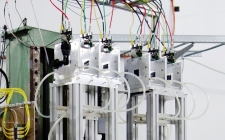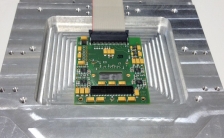The DURANTA telescope installed in area TB22 at DESY II test beam
One of the most important test beam equipment is a telescope for particle tracking. Beam telescopes allow to investigate future particle detection sensors (DUT = Device Under Test). At DESY, the telescope crew provides dedicated support for the installed beam telescopes and is actively working on the development of new beam telescopes and the connected DAQ and reconstruction software as well as on R&D for novel silicon sensors.
EUDET-type Beam Telescopes
At DESY, EUDET-type pixel beam telescopes are available as high-precision tracking tool for detector development. This type of beam telescope originated from a EUDET project using Mimosa26 sensors and replicas of this pixel telescope are as well operated at CERN, SLAC and ELSA (U Bonn).
These telescopes provide a high-precision beam tracking (~ 2 μm), a sufficient event rate (~ 2 kHz rate at 10 kHz beam rate) and an easy integration capability of DUTs. Operated by the EUDAQ and EUDAQ2 framework (DAQ software) and analysed with the legacy EUTelescope or state-of-the-art Correyvreckan offline reconstruction software, the telescopes offer the whole infrastructure for detector development from measurement to results.
ALPIDE Beam Telescopes
A telescope prototype called “Adenium” has been installed in beamline TB22. This is based on the ALPIDE pixel sensors, originally developed for the ALICE experiment at the LHC. They have a sensitive area of 1.5 cm x 3.0 cm and a pixel pitch of 29.24 μm x 26.88 μm. They can reach a comparable tracking resolution to the EUDET-style telescopes of down to about 3 μm and are about 10 times faster than the MIMOSA26.
From the user’s perspective in terms of operation, the prototype looks like a EUDET-type telescope - including the option to mimic the MIMOSA26 data format. In thsi way, it can be seamlessly integrated in existing setups and has been running successfully since its installation. The concept is currently being developed into a final system and several copies are planned.
| Please use these publications for reference |









